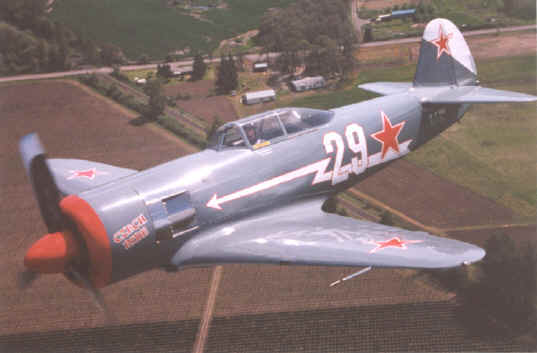|

This Yak-11, "Czech Ride," N11MQ,
was
modified for air racing. At the time of this photo, it was owned and flown by Sam Richardson. Photo by Jack Cook.
History: Shortly
after the end of World War II, an American clergyman who had lived in Moscow during that
period described the air war thus, "The Nazis would fly over the city dropping
leaflets goading the Russians to send up something worth fighting."
No doubt that was either in 1942 or early 1943,
because 1943 was the year that the Soviet Air Force answered the challenge with a
vengeance, fielding aircraft from several designers that could go head-to-head with the
best that the Luftwaffe had available. Among these, was the Yakovlev Yak-3,
an aircraft that would become the most-produced Soviet fighter of the war.
A light, responsive, single-seat interceptor, bomber escort and
close-support aircraft that was especially deadly to Luftwaffe aircraft at altitudes below
11,000 feet, the Yak-3's success in combat led to the conversion of a Yak-3U to two-seat
trainer prototype, the Yak-3UTI in 1945. That "cut-and-paste" redesign was
followed 12 months later by the first flight of a new, air-cooled, two-seat advanced
trainer/liaison aircraft/utility transport, the Yak-11, which
used many Yak-3 parts, modified as needed for the aircraft's new functions.
Nicknamed "Moose," by NATO and "Hawk" by Warsaw
Pact nations, the Yak-11 was, in its trainer form, significantly less nimble than its
fighter predecessor, except for demonstrating exceptional agility in rolls.
Sometimes equated with the North American T-6
trainer in terms of its widespread use, 3,859 basic Yak-11s were produced through 1956.
Although production then ceased in Russia, it continued in Czechoslovakia, where it had
been licensed to LET in 1953 with the designation C.11. An
additional 707 of those aircraft were manufactured by LET. Many of the Yak-11's still
operational in the USSR were replaced in 1958 by the Yak-11U, a
tricycle-geared variation of the aircraft intended for training jet fighter pilots. Yak-11/C.11's were used not only by Warsaw Pact nations, but
also by various other communist countries around the world.
While it is no longer a front-line aircraft, the
Yak-11 has gained a new lease on life as a popular "warbird" thanks to its World
War II Yak-3 lineage. Modified (in several instances as high-performance single-seat
racers), and equipped in some cases with Pratt and Whitney engines, Yak-11s may currently
be found in civilian use from Reno, Nevada to Western Australia, with specific airframes
known to be in service in Belgium, the United Kingdom, France, Sweden and the Czech
Republic.
Nicknames: Hawk (Warsaw Pact name);
Moose (NATO codename).
Specifications:
Engine: One 570-hp Shvetsov ASh-21 radial piston engine
Weight: Empty 4,189 lbs., Max
Takeoff 5,379 lbs.
Wing Span: 30ft. 10in.
Length: 27ft. 10.5in.
Performance:
Maximum Speed:
289 mph
Ceiling: 23,295
ft.
Range: 795 miles
Armament: One 12.7-mm (0.5-inch) UBS or
7.7-mm (0.303-inch) ShKAS machine gun.
Number Built: 3,859, plus 707 Czech-built
C.11s.
Number Still Airworthy:
50+, most in
eastern Europe.
Links:
Yak UK
|
Yakovlev Yak-11
Wall Decal
from Amazon.com:
|

[Back to Warbird Alley's Main
Page]
All text and photos Copyright 2016 The
Doublestar Group, unless otherwise noted.
You may use this page for your own, non-commercial reference purposes only.
 |